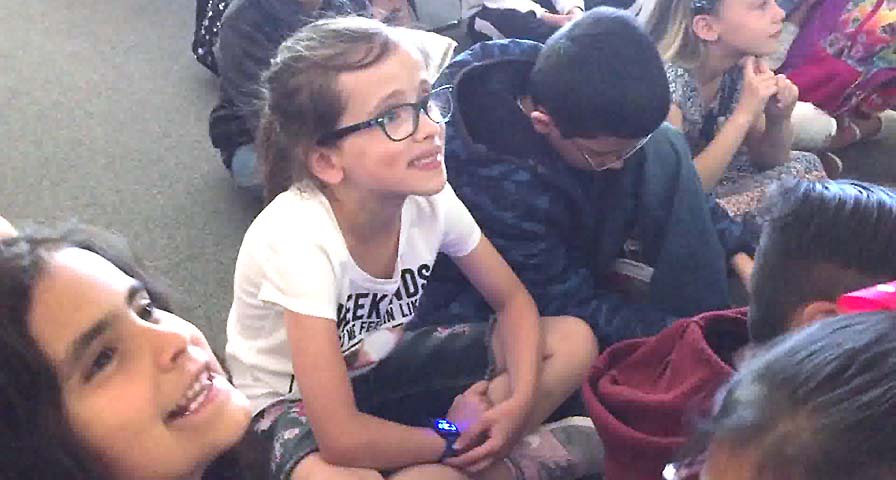Schools find as much success with their IHT ZONE heart rate monitors teaching students to regain control of their emotions as they do encouraging them to get their heart rates up while exercising.
From counselor-led programs in Littleton Public Schools and Braham Public Schools to adapted PE programs in Ann Arbor Public Schools, students of all ages and learning abilities are improving their emotional health with cues from their wrist-worn heart rate monitors.
 “Not only can IHT be used for exercises and learning about one’s heart rate, but it is a great tool for infusing Social Emotional Learning, monitoring emotions, and self regulation strategies," Adapted PE Specialist Toni Bader said. "This tool is student friendly in its usability and engages and empowers students to learn and take action on their health.”
“Not only can IHT be used for exercises and learning about one’s heart rate, but it is a great tool for infusing Social Emotional Learning, monitoring emotions, and self regulation strategies," Adapted PE Specialist Toni Bader said. "This tool is student friendly in its usability and engages and empowers students to learn and take action on their health.”
Heart Rate in a SEL-Focused Curriculum
Kim Bailey, a counselor at East Elementary School (Littleton Public Schools, Colo.), created a two-phased program to help young students gain control of their emotions throughout the school day. Working with her campus administration, Bailey built a curriculum that included emotional regulation lessons from “In Focus.” The curriculum gave students strategies by which they could calm down when they felt their emotions spike – both with excitement and, more likely, stress and anxiety.
To help students “see” when their emotions spiked, she introduced the IHT ZONE heart rate monitor. Wearing the heart rate monitor, students could see their heart rate change based on the color of the monitor and tie that to their emotions:
- Blue signifies calm and happy along with a resting heart rate
- Yellow indicates excitement, frustration or worry along with an elevated heart rate
- Red indicates joy, fear, stress or anger along a highly-elevated heart rate
“The vision is to link children with regulating their emotions, being able to physically see what’s happening in their body,” Bailey said. “Then they can associate that with the feeling and they are able to use the techniques we’re using to help calm themselves down.”
It didn’t take long for that connection to show. After a few In Focus lessons, students put the techniques into practice.
“I was able to watch a student in week one who was having an emotional moment where he was struggling,” Principal Kelly Card said. “He was upset about things and he was able to look at the number on his and incorporate some of the breathing exercises we had been learning about. He sat and watched the number on his go down and get into his normal range, which was so cool to see….especially for this particular student.”
Another second-grade student said the program helped her.
“I was really emotional and now I’m a little bit stronger and calmer,” said second-grader Charlotte Sherwood. “I feel it’s made a big difference since I started wearing the monitor.”
Since the Operation Dragon Heart pilot at East Elementary, the district implemented the program in all of the district’s elementary schools.
Teaching Students to Practice Calming Breathing Techniques
 To help students across her elementary school manage their emotions, Braham Area Elementary School (Minn.) social worker Jonelle Klemz introduced the IHT ZONE heart rate monitors to every student – visiting a different class each week throughout the year.
To help students across her elementary school manage their emotions, Braham Area Elementary School (Minn.) social worker Jonelle Klemz introduced the IHT ZONE heart rate monitors to every student – visiting a different class each week throughout the year.
“We talk about how our body feels,” she said. “The third graders don’t always know if they are hyper because they’re excited or because they are anxious. This gives you a chance to learn that about yourself. So I tell them they are scientists this week and you’re studying yourself. You get to see how different things feel.”
When students feel their emotions ramp up – whether they are experiencing the stress of taking a test or frustration because the day simply isn’t going their way – they can see that change in their heart rate. Klemz reviews the heart rate data with each student and said students are typically quick to figure out why their heart rate rises and falls at certain times. For some, it can be eye-opening, how and when their heart rate triggers a behavioral change.
One student saw his heart rate spike during PE class, but not solely because he was exercising at a maximum level.
“I asked what he was doing, and he didn’t answer and put his head down,” Klemz recalled. “I finally asked if he remembered and he said, ‘I remember, I was mad the whole time.’ Kids were cheating at the game they were playing, and he got mad, and he couldn’t calm down.’”
But, thanks to the morning breathing and stress management lessons, he regrouped and eventually brought his heart rate back down, letting go of the anger.
“That’s a student who would have been upset the whole day,” Klemz said. “We looked at his chart and he was blue the rest of the day. So I just told him how proud I was of him that he didn’t let that wreck his day. Typically, he would have been off all day. He said he did the breathing and it made him feel better.”
Connecting with Adapted PE Students
Ann Arbor Public Schools Adapted PE Consultant Deak Swearingen immediately recognized that the IHT ZONE could benefit his students despite their sometimes significant physical and cognitive difficulties.
Many of Swearingen’s students work with 1:1 para-educators who help guide students during the day. Wearing the IHT ZONE heart rate monitors, the para-educator can see when the student’s heart rate doesn’t match their exertion level and can prepare to provide help as needed.
For students who don’t require that 1:1 assistance, the heart rate monitors have proven very effective in teaching students when they need to take steps to regain control of their emotions. The students may not have the ability to understand their heart rate and what that means, but they now recognize that when their monitor turns red, they need to take steps to slow their heart rate down.
“I have a student who has behavior issues, and her issues can be quite severe,” Swearingen recalled. “This student has learned that when she senses her anxiety begin to spike, she would actually ask me to go out on the track instead of being in the fitness center.”
As the student’s anxiety spikes, her heart rate monitor turns red - the visual clue she can attach to the feeling. When this happens, she goes to the track, away from the source of the anxiety, and walks until she calms down - as evidenced by her heart rate monitor turning yellow and then blue.
“That’s the visual component,” Swearingen said. “They understand this, and that is transcending.”
Make the IHT ZONE heart rate monitor part of your School's Student Wellness Program




